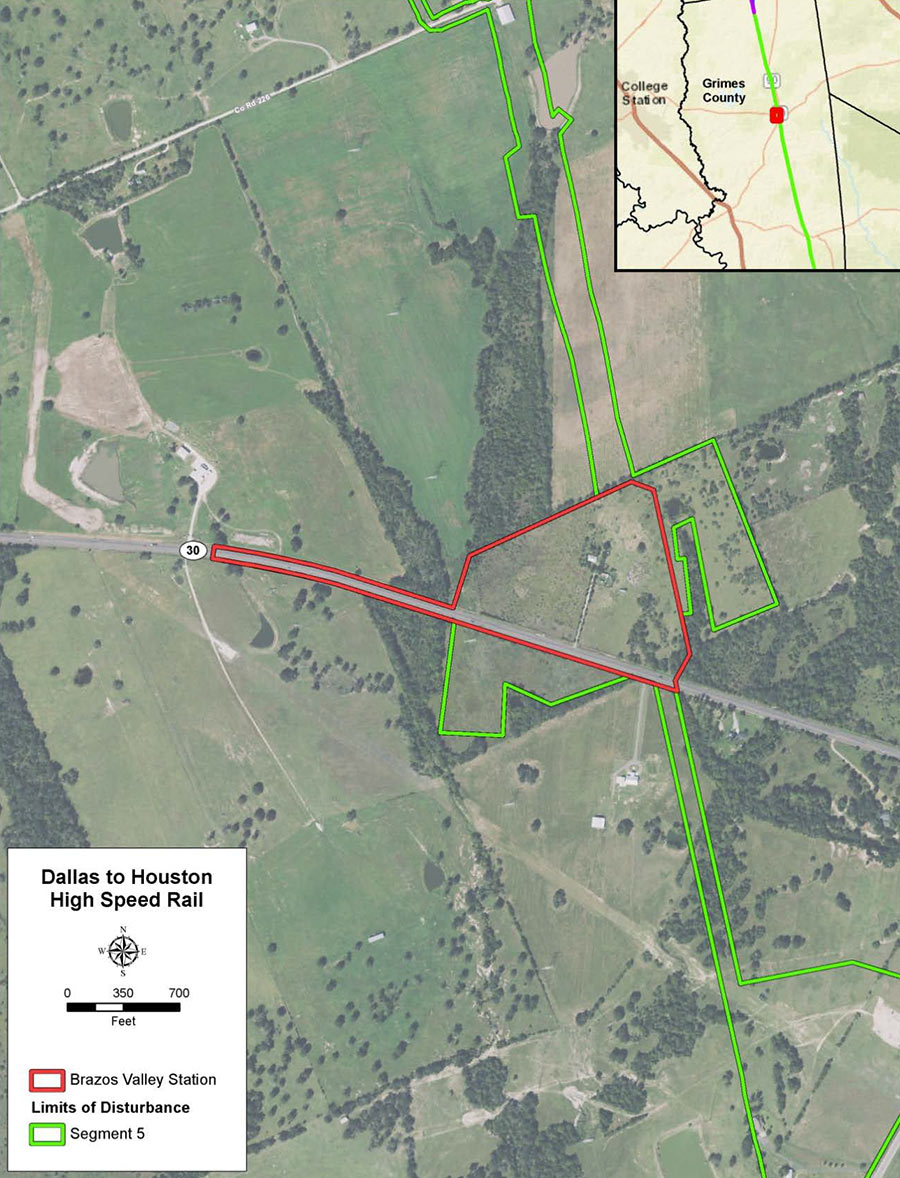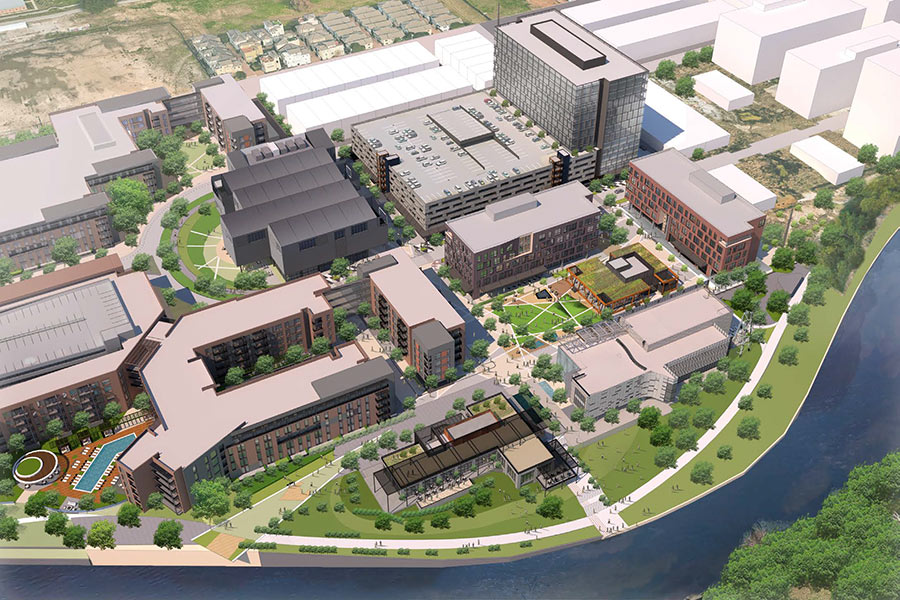COMMENT OF THE DAY: LET THE COLLEGE STATION LAND RUSH BEGIN!  “The station in Roans Prairie is a developer’s dream: high-speed rail, new I-14 interstate, and miles and miles of undeveloped land. The master-planned communities will start popping up in no time. Work in the city (Houston or Dallas) and live out in the country on your acreage homestead. Just wait, the Bryan-College Station-Huntsville MSA will see the fastest population growth in the entire nation for years and years to come.” [Thomas, commenting on Proposed High-Speed Rail Line’s Bryan—College Station Station Would Be 27 Miles East of Texas A&M] Map of proposed Brazos Valley Station: Federal Railroad Administration
“The station in Roans Prairie is a developer’s dream: high-speed rail, new I-14 interstate, and miles and miles of undeveloped land. The master-planned communities will start popping up in no time. Work in the city (Houston or Dallas) and live out in the country on your acreage homestead. Just wait, the Bryan-College Station-Huntsville MSA will see the fastest population growth in the entire nation for years and years to come.” [Thomas, commenting on Proposed High-Speed Rail Line’s Bryan—College Station Station Would Be 27 Miles East of Texas A&M] Map of proposed Brazos Valley Station: Federal Railroad Administration





I-14 must also be an Aggie design …. besides being totally unnecessary, it has an extremely poor planned track with hundreds of miles of unless expenditures essentially paralleling I-10 on the west and no logical destination on the east. You obviously gotta love wanton political graft, but I wonder who it is designed to make rich?
WR,
Parrelleling I-10 is the point.
I-10 is a congested freight corridor from Pensacola to San Antonio. I-14 is meant to avoid major metropolitan areas.
With a little luck I-14 will be mostly automated and will be tolled to an extent never before seen.
The college station land rush alluded to in the title will be mostly retirement communities, in this case with easy high-speed rail access to the grand kids. These stations will not spawn Blade Runner cities (unfortunately). Anyone hoping to stick around and catch a glimpse of something innovative and unprecedented and stunning is better off just moving along.
I disagree with kjb434 on this one. I think that it is important that individual interstate corridors connect population/activity centers and not merely attempt to bypass them over long distances. The whole point of having them is that they get used; that they are used is how we know that they are successful. If we are bypassing primarily as a means of dealing with congestion, then existing corridors need to be widened.
.
Whatever the stated purpose of the I-14 project is, I’m pretty sure that the subtext of it is that it is somebody’s pork barrel project. There are lots and lots of alternative opportunities for spending money on the interstate highway system that make more sense than this.
A daily commute using the rail is still a tough sell. Ticket prices are competing with airlines and buses so It will likely be cost prohibitive for the average person to make this a daily commute. Plus you have to have a reliable way to get to your office from the NW terminal. If your office isn’t close by, you are still dealing with a tough Houston commute.
–
That being said, this is a good location for folks who want occasional access to the city. Retirees, consultants, work from homers, 2nd home in the country folks could all make this work. Great spot for grandparents with kids in Houston or Dallas. The kids can visit pretty easily here.
I think that Commenter7 is correct, and that there will be throngs of Realtors and Brazos Valley boosters that are able to pitch the prospect of that lifestyle and make a sale. It won’t be a huge number of sales by comparison with any suburb of Houston, but it will be a huge number by comparison with what’s going on in Grimes County right now. I would also be wholly surprised if TCR didn’t sell commuter passes that average out to some huge discount for people who want to re-order their lives such that they can live out a ‘TCR lifestyle’. I mean, once they have the big cap-ex out of the way and once they’ve got a locomotive on the tracks, the variable costs of adding capacity for commuters would be very very low.
Can we finally get our Disney Park? Maybe, right here. DisneyTexas
The Gulf Coast Freight District which includes Harris and Grimes counties will have 2 stations inside its jurisdiction. The district which also has been giving authority to develop commuter rail has no means of income. By law it can not own or invest in any freight terminal railroads nor does it have the authority to assign a tax. It does however have the power to issue bonds. If the district used the revenue from the bonds to aquire land and develop master plan districts around the stations in theory this would generate capital to begin to construct the districts master plan projects. It would lessen the debt on the train developers as well. The HSR is a great idea…..it will work.
Get a big player to relocate HQs to Roan’s Prairie and you have the nucleus for a new population center.
.
Anyone know about ETJs and Home Rule?
Seems I heard that The Woodlands (not yet annexed by Houston) could never become its own City because so close to Houston.
…that TX cities are protected by some rule that maintains a certain distance between them.
Could Roan’s Prairie be at just the right location?? (Future name: Tamupolis, TX)
I agree with Niche that there should be more stops and we shouldn’t just treat rural texas like flyover country. The issue is stop times.
–
In England, the trains cover smaller cities. Its stops, opens its doors for a few minutes and then goes. I don’t mind stopping a few minutes as a passenger. Every passenger is responsible for knowing the stop and getting a move on when it is time to go. None of this sitting around forever like they do at the light rail. If you miss the train, there will be another one.
@ Commenter7: I’m not saying that there ought to be a whole lot of stops. Truly fast transportation spends a fair bit of time accelerating and decelerating in addition to time allocated to boarding — and inter-city transportation needs to stop for long enough to let the people that are boarding get situated. The optimal number of rural stops is probably just the one, and even this one which is kinda sorta close to B/CS is stretching it. The trend that I’m talking about would be witnessed immediately in terms of real estate marketing and community boosterism, but much more slowly in terms of actual demographic change and ridership levels. (Also, in 2021, the oldest baby boomers will be 76 years old, already well beyond the stage of retirement where a person moves to the countryside for the lifestyle and social identity. There are going to be some headwinds on this trend, and a fair number of existing homes in the countryside that need to be back-filled by a smaller population of younger retirees. It’s pretty much all downhill from there.)
I have two separate contributions to this convesation:
I spoke to Judge Eckels at a Rotary meeting about a year and a half ago. He said that most of the rail from the Houston Station out to the farthest reaches of Northwest Houston would be on pylons. He said that it was the intent of TCR to develop the under pylon part into some type of mass transit. He did not indicate whether it would be rail, BRT or what have you. But it signaled the intent of TCR to develop the under pylon part as a revenue center.
I have an anecdotally supported thought to add to the notion of Bryan/College Station as a future bedroom community of Greater Houston. My son lives in Reims, France and he tells me that there are a significant number of former Parisians who live within driving distance of the Reims TGV Station and commute to Paris on the TGV. Central Paris living is so expensive(try 800 to 1000 dollars a square foot to purchase an apartment), that some of those who can afford to, choose to live on estates outside of Reims(Where you can get a really nice, large old farm house for less than 400k) and ride the thirty minutes in to Central Paris. I could easily see the same happening here with those who can afford Inner Loop, Galleria, or Memorial but prefer something more palatial, if the commute can be held down to less than thirty minutes. At 200 mph, Bryan College station is only 22 minutes from the prospective Houston station.
Bad news, guys: UH considers the high-speed rail to be competing with its campus shuttle bus and is holding emergency meetings to block construction of the Northwest Houston and BCS stations. More on this story as it develops…
So many people use the Oyama-Tokyo segment of the Tohoku Shinkansen as a commuter route that they’ve historically run double-deck trains with slightly crappier top speed relative to the longer distance cruisers. So yeah, this is absolutely going to be a thing.
I’ve even met London commuters that live as far away as Liverpool and ride the 2 1/2 hours into London on a daily basis. They do it for the cheap housing and because commuting within London is also a pain in the ass; also, the folks that I’ve met profess to be able to work while on the train. There’s little question that this lifestyle will appeal to some people in Texas…but not nearly as large of a proportion out of our (smaller) population. We need to be very careful about making comparisons between Houston and cities like Paris, Tokyo, and London — or just not do that at all.
This lady has a 6-hour commute each day but the story also mentions a guy with an 80-minute door-to-door commute each day. That’s definitely an improvement over driving. And those trains are really slow.
http://www.latimes.com/local/california/la-me-lopez-commute-cherry-20171216-story.html